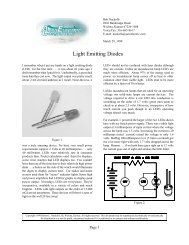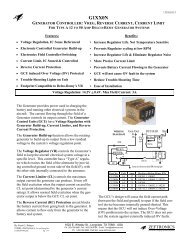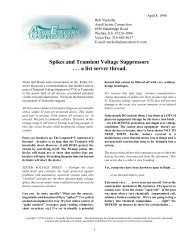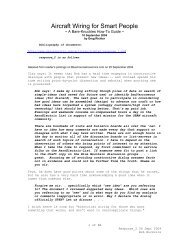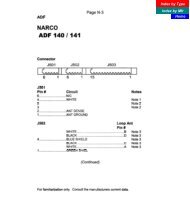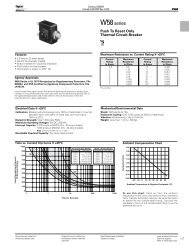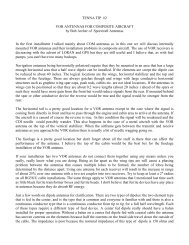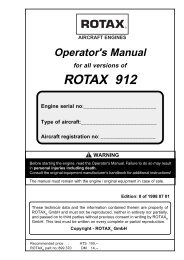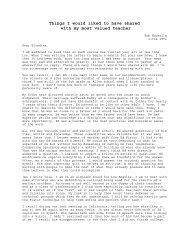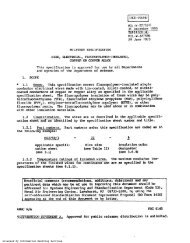Myths of Multiple Battery Installation - AeroElectric Connection
Myths of Multiple Battery Installation - AeroElectric Connection
Myths of Multiple Battery Installation - AeroElectric Connection
Create successful ePaper yourself
Turn your PDF publications into a flip-book with our unique Google optimized e-Paper software.
(particularly lead-acid) in our airplanes. A lack <strong>of</strong>understanding about how batteries operate providesfoundation for the most popular myths.When a power generation system is operating properly,the system bus will be supported at or above 13.8 volts,typically 14.2 to 14.8 volts DC. 13,8 volts is the “ideal”charging potential for fully charging a lead-acid battery atroom temperature. Nobody runs a system at that voltagebecause after engine starting, we generally want toRECHARGE a battery in a few minutes <strong>of</strong> operation. Asthe battery approaches full charge on a 13.8 volt bus,recharge rate (charging current) tapers slowly to zero. Thetime to top-<strong>of</strong>f a seriously discharged battery on a 13.8volt bus may be longer than the run-time for thatparticular flight cycle.Practitioners <strong>of</strong> the art discovered that a lead-acid batterycan be moderately abused (higher bus voltage) withoutseriously affecting service life <strong>of</strong> the battery. Setting thebus voltage as high as 14.6 volts gets the battery topped<strong>of</strong>f with dispatch a few minutes after take-<strong>of</strong>f. The fewhours <strong>of</strong> flight-time (battery abuse) per week <strong>of</strong> servicehas little effect on number <strong>of</strong> flights one can expect beforethe battery is replaced. Indeed, our automobiles have beencharging lead-acid batteries at the 14.2 to 14.8 range fordecades. Our car batteries get “abused” much more hoursper year than do our airplane batteries. Yet it is notunusual for a car battery to perform as needed for threeyears or more.Myth 1: You should charge a battery based on somepr<strong>of</strong>ile tailored to the battery’s technology.This myth has prompted a proliferation <strong>of</strong> “smart”chargers that feature front panel controls that might belabeled “AGM”, gell-cell and “deep-cycle”. The idea isto <strong>of</strong>fer an idealized recharge mode for the purpose <strong>of</strong>maximizing battery life. A typical product line <strong>of</strong> verycapable smart chargers is illustrated at:http://tinyurl.com/6nf7v3These are great products. I own and use several models <strong>of</strong>Schumacher products. But let’s think about this a bit. Thealternator/regulator combination in our airplanes andautomobiles are anything but “smart”. There are nocontrols for giving these systems responsibility foridealized battery life.The design goal for vehicles is to recharge a batteryquickly and live with the small, difficult to measuredegradation <strong>of</strong> battery life resulting from a less-than-idealrecharge pr<strong>of</strong>ile. If one wishes to maintain a lead-acidbattery in storage, the most useful feature in the batterycharger/maintainer is to “top <strong>of</strong>f” the battery (an activitynot unlike what occurs in your airplane or car). After top<strong>of</strong>f,the charger drops to a maintenance voltage just abovethe battery’s at-rest open circuit voltage (about 12.9 voltsat room temperature). This functionality is plotted outhere:http://tinyurl.com/553kmuThis is recharge curve was produced by the SchumacherModel 1562 charger/maintainer sold by Walmart and otherstores for about $20. This particular charger has no frontpanel controls for tailoring the recharge pr<strong>of</strong>ile . . . but it’sjust fine for recharging and maintenance <strong>of</strong> any 12v leadacidproduct.Routinely deep-cycled batteries for wheelchairs, lawnmowers, trolling motors, golf carts, etc. may demonstrateimproved battery life with a tailored smart-charger. Afterthese specialty chargers complete a top-<strong>of</strong>f cycle and go tothe maintenance mode, they’re all the same. However, inthe ideal world, our airplane and automobile batteries arenever deep-cycled. Further, there are no realistic benefitsto be secured by the occasional tailored top-<strong>of</strong>f mode usedon a battery that receives an extended, non-tailored top-<strong>of</strong>fcharge every time you go flying. A “smart”charger willprobably enhance service life for a battery that is routinelydeep-cycled. They are <strong>of</strong> little value in maintainingbatteries in vehicles where the battery’s primary task is tosimply get the engine started a couple times a month. Itcertainly doesn’t hurt to use a “smart” charger on yourairplane . . . but it doesn’t add perceivable value either.Myth 2: Systems fitted with more than one battery needsome form <strong>of</strong> “isolation” to prevent deleterious armwrestlingbetween the two batteries.Batteries charge based on the voltage applied to theirterminals. This voltage is set by the alternator’s voltageregulator. When the alternator is operating normally, anynumber <strong>of</strong> batteries can be hard connected to the bus. By“hard connection” we mean a switch, relay or contactorhaving a very low resistance. Diodes (solid state checkvalves for electrons) waste energy and limit architecturechoices for how power is put into or removed from abattery.When the alternator is not producing power (for what everreason) the bus voltage drops from a charging level (14.2to 14.8 volts) to a battery discharging level (12.5 andlower). My electrical system designs always include someCopyright 2008 Robert L. Nuckolls, III, Wichita, Kansas. All rights reserved. This document may be reproduced electronically or mechanicallyfor distribution in a not-for pr<strong>of</strong>it, educational endeavor if it is published in its entirety and without modification.Page 2
form <strong>of</strong> active notification <strong>of</strong> low voltage. I.e, a light thatturns on when the bus falls below 13.0 volts.Okay, the light is on. Now what? Your plan-B should reconfigurethe system for battery-only operations. (1) Shutdown unneeded equipment. (2) Partition batteries to theirassigned tasks. (3) Shift flight management to anendurance mode that maximizes use <strong>of</strong> the scarceresource: stored energy in the batteries.Myth 3: Batteries <strong>of</strong> different capacities should not bedirectly paralleled for the purpose <strong>of</strong> exploiting theenergy they have stored.The only reason to have two batteries in tandem is toincrease total capacity. If you parallel a 12 a.h. battery anda 7 a.h. battery, you now have 19 a.h. <strong>of</strong> energy storage.You can parallel them for charging and discharging whileexpecting to (1) top them <strong>of</strong>f during charge and (2) use allenergy they contain on discharge.Interestingly enough, it matters not whether the smallerbattery is rated at 7 a.h. when new . . . or happens to be a12 a.h. battery at end <strong>of</strong> service life. It doesn’t matterwhat conditions have caused two batteries to be differentcapacities. Both batteries will deliver all their containedenergy. Except for the now exceedingly rare instance <strong>of</strong>shorted cells, a battery <strong>of</strong> any size, condition or state <strong>of</strong>charge will not “sap the precious bodily fluids” <strong>of</strong> anotherbattery.Now, why would one wish to install more than onebattery in an airplane? It depends on design goals. Forexample, float planes that have kicked <strong>of</strong>f from the dockand are now drifting downstream can be in deep doo-dooif you can’t get the engine started. I’ve helped folk installsecond batteries inside floats that are simply paralleledwith the standard ship’s battery on it’s own contactor.This dual battery installation serves but one purpose. Itincreases the odds that at least one battery will beavailable to crank the engine in spite <strong>of</strong> failure <strong>of</strong>contactor or battery master switch.How about a single alternator airplane with electricallydependent engine and flight instruments? If the alternatorquits, one might wish to assign batteries to Task 1(engine) and Task 2 (instruments/communication). In thiscase, the two suites <strong>of</strong> hardware are powered from theirown battery busses. Contactors that parallel the batteriesto the main bus are simply opened. The main bus goesdark and system components that depend on batterypower enjoy separate, isolated sources.Another example for dual battery installation is illustratedat:http://tinyurl.com/54wszuandhttp://tinyurl.com/6s4mebIn this case, we have totally independent systems with across-feed capability. In normal operation, the twobatteries are supported by their own alternator. Should onealternator fail, the pilot has the option <strong>of</strong> closing the crossfeedcontactor thus paralleling both batteries and theirbuses on the remaining alternator. This is a perfectlyrational thing to do. One may also close the cross-feedcontactor to add both batteries capacities together duringengine cranking.If you have questions about batteries or any othercomponent <strong>of</strong> your proposed electrical system, I suggestyou take advantage <strong>of</strong> the <strong>AeroElectric</strong>-List hosted byMatronics. This service is free. You can sign on and sign<strong>of</strong>f at your pleasure. The service is described and linked at:http://tinyurl.com/57wytbThis service is supported by about 1800 builders and aseveral dozen knowledgeable individuals (including yourstruly) who are willing to share their time and expertise inmatters electrical.Copyright 2008 Robert L. Nuckolls, III, Wichita, Kansas. All rights reserved. This document may be reproduced electronically or mechanicallyfor distribution in a not-for pr<strong>of</strong>it, educational endeavor if it is published in its entirety and without modification.Page 3


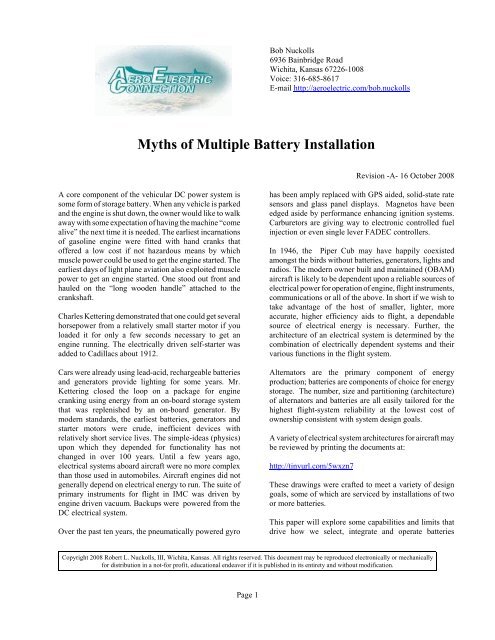
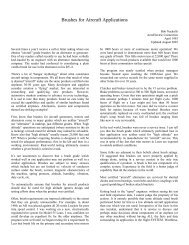
![G-Series-Ext [pdf] - Carling Technologies](https://img.yumpu.com/50918301/1/190x245/g-series-ext-pdf-carling-technologies.jpg?quality=85)

